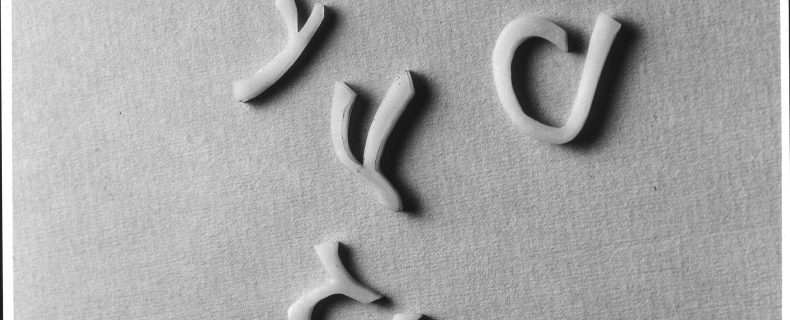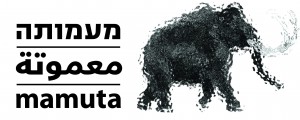The Private Press in the Small Room

The Private Press in the Small Room
Hadassa Goldvicht and Ariel Wardi
1.11.23-12.1.24
Mamuta Art and Research Center
Tue-Thur 12:00-16:00, Fri 10:00-14:00
* Due to the situation, the exhibition is open at varying times, you can keep up to date on our Facebook *
About opening an exhibition during wartime
In the week in which this exhibition was meant to open, the reality of our lives as we knew it, changed deeply, horrifically, unimaginably.
At first we stood still, muted. It seemed that there was no purpose for art or words, and any effort would be meaningless, doomed to futility. However, as the weeks went by we chose to return and complete the installation of the exhibition, in an attempt to find something familiar to hold on to in the reality we knew before October 7th.
In this renewed state, new meanings began arising from the works we were installing: books breaking down into primary elements, Hebrew letters constructed in new, abstract ways forming an alternative clear voice, and the Morse code that Wardi carried with him with such clarity for decades, as a language of war, suddenly echoing a dormant past into our current reality.
When Goldvicht and Wardi chose the books that Wardi would read in Morse code, they decided on choose texts that had in there essence a voice calling out from the depths of a sea, either like the actual sea from which Wardi had sent out morse code messages in his youth, or from other kinds of deep seas we encounter throughout our lifetime.
Now, at a time when the depths of our days are dark beyond belief, these cryptid texts are calling out from within the exhibition spaces, as if they are voices waiting to be heard on the other side, bringing meaning and grace. We are in the midst of learning, live, what art needs to be now, and of its potential of carrying comfort and guidance.
===
Over the past three decades, Ariel Wardi has been working in the “small room”– that serves as a studio and tiny private press where he prints and binds books, stacked in a tower rising as high as the ceiling. In his private press, he uses traditional printing techniques long abandoned by the commercial printing industry. Wardi developed unique methods to cut and create his own type, printing on a Vandercook Letterpress, sewing and binding the books by hand. Every one of the hundreds of books has a unique binding, some made of sand and earth. Each book is distinct, each copy essentially an original. Wardi, born in 1929, is one of the last people in Israel to work in traditional printing press methods.
In contrast to the act of printing inherently meant for mass reproduction and distribution, Wardi’s stacked books constitute a fundamentally private body of work, much like drawings placed in a file cabinet. As the years passed, once he could no longer precisely set the typeface, Wardi replaced text with abstract prints, creating original techniques in which the “moment” of the action and the encounter between substances – the mix of inks, turpentine, and the pressure of the press impact the final result. Wardi binds the prints by hand into books. Thus leafing through the book page by page, creates the narrative; observing replaces reading.
Artist Hadassa Goldvicht (b. 1981) as initially trained as a printmaker. Her works explore the relationship between language as raw material and the body, engaging in the visual and sensory deconstruction of language and letters, and investigating different forms of reading and writing. Throughout the encounter with Wardi and his oeuvre, the two found they shared a common language.
Goldvicht began to document Wardi’s work based on a shared fascination with language and methods Wardi has been exploring over the past decades.
Wardi was a wireless operator on ships carrying illegal immigrants and arms in the 1940s, and is still fluent in Morse code – a language which transforms the sound of the letters into a system of dots and dashes. In Goldvicht’s multi-channel video and sound installation, Wardi reads from his books “Ashrei Ha’ish” (Psalm 1:1-4)”, “ Jonah”, and “Psalm 104” in Morse code. Wardi translates the books into Morse code’s binary system in two different ways: First, tapping the letters with his fingers; and second, vocalizing the letters in Morse code. The sounds of the books are broadcast throughout the different exhibition spaces, preserving the essence of the original printed words. The installation engages in the abstraction and deconstruction of the Hebrew language, the relationship between language and time, and the new options that emerge when encoding language from sounds that become letters, from letters encoded as dots and dashes vocalized as sounds and back again to letters.
Goldvicht and Wardi’s collaborative exhibition presents Wardi’s unique print work and his dialogue with traditional print techniques.
Wardi’s tireless search for the “original” in the art of printing, the quintessential act of creating a replica, becomes a manual “hack”*1 and a subversive pursuit of beauty. Goldvicht, whose early work in printmaking evolved into the material abstraction of video and sound, continues her in-depth research on the sensory and material meanings of letters and words, reflected in her current collaboration with Wardi.
This joint exhibition connects the disciplines of art and craft, technology and the handmade, and invites viewers to experience a profound encounter with typography and the deconstruction of reading: the letters themselves have become raw material, and with their transformation into binary forms, have turned into sound.
*1 Manual Hack = To apply a trick, shortcut, skill, or novelty method to something to increase productivity, efficiency or ease. (https://en.wiktionary.org/wiki/hack)
Curator: Ada Wardi | Artistic and curatorial guidance: Lea Mauas | Production: Naama Mokady | Technical manager: Eitan Haviv | Table construction and woodwork: Daniel Eichenberger and Ayala Shamir | Hebrew Editing: Alma Cohen Wardi| English translation: Tamar Cohen, Judith Appleton | Arabic translation: Anwar Ben Badis | Exhibition space coordinator: Gaya Or-Ner Adani | Graphic design: Ada Wardi
Video Installation – Camera: Hadassa Goldvicht, Yoram Milo; Sound: Binya Reches; Video consulting: Dotan Goldwaser
Print Process Video Documentation – Camera: Ada Wardi; Editing: Naomi Ben David
This exhibition is dedicated to the memory of Dina Wardi, Ariel’s wife, who passed away during the preparations for the exhibition.
Thanks to the Israel Ministry of Culture and Sport and to the Jerusalem Municipality for their generous support for this exhibition.
Image: Ariel Wardi, Hand cut letters inspired by the letter David Corsiva
===
More events as part of the exhibition:
Gallery talk and a tour at the exhibition, with Ariel Wardi, Hadassa Goldvicht and Leah Mauas, 17.11.23, 10:00
Open tours with Hadassa Goldvicht: 30.11, 12:30 | 14.12, 12:00 (as part of the Manofim Festival) | 22.12, 12:15
3D printing workshop with David Lockard as part of the “Breathing Space” events at Hansen House: 12.12, 16:00-18:00, in the cafeteria.
Bookbinding workshop with Hadassa Goldvicht as part of the “Breathing Space” events and the Manofim Festival: 14.12, 2-4 p.m., in the cafeteria.
Closing event at the exhibition: tour and open conversation with the artists: 5.1.24, 10:30


